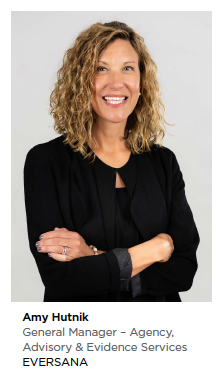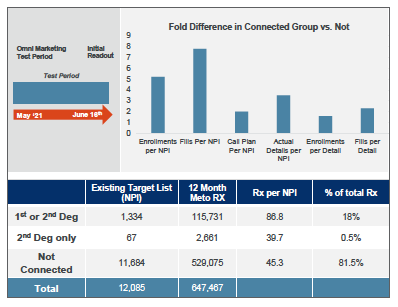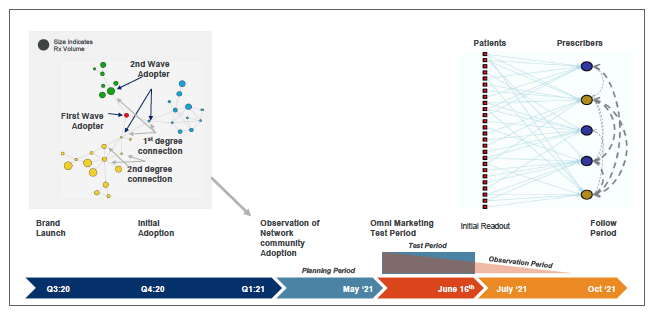 In today’s competitive global market, pharmaceutical companies can’t afford to waste time or resources on strategies that don’t generate scripts or fit product and patient needs.
In today’s competitive global market, pharmaceutical companies can’t afford to waste time or resources on strategies that don’t generate scripts or fit product and patient needs.
Without data-informed, fully integrated campaigns, there’s a missed opportunity to mine deep insights that can inform next steps and accurately pinpoint efforts to doctors and patients who could benefit from additional touchpoints during the campaign, yielding higher results.
Rather than guessing which HCP targets most disproportionately impact script fills, tracking provider networks through data and analytics can provide discrete insight for creating more effective, targeted provider outreach strategies. When data is actively and regularly informing campaign design, execution and interconnectivity, insights and messaging become aligned, and there’s a higher probability that scripts will be filled.
Case Study: Tracking Provider Networks
Knowing where to purposefully spend investments for targeted outreach continues to be a challenge. EVERSANA recently sought answers to this industry challenge by studying how to optimize targeting across field, marketing and patient services teams. They wanted to specifically know which providers are impacting product script adoption and fills within patient groups and among other providers. To conduct this study, the team leveraged collective prescriber data to adjust targeting strategies and upturn the script trajectory for a client’s product six months after launch.
 After initial adoption of the product, a treatment for gastroparesis, a pattern began to emerge among prescribers: Most of the second-wave prescribers were connected to the initial prescribers through the same network of patients. With this observation came new questions:
After initial adoption of the product, a treatment for gastroparesis, a pattern began to emerge among prescribers: Most of the second-wave prescribers were connected to the initial prescribers through the same network of patients. With this observation came new questions:
Is script adoption following a network?
Would targeting the network with marketing be more effective than current strategies?
Similar to Facebook, which helped pioneer the concept of social networking, drug adoption tends to follow similar network patterns among providers. For example, as demonstrated in the images below, when connectivity across an entire prescriber network can be evaluated, communities emerge. In this case study, two communities within the gastrointestinal provider network emerged, allowing EVERSANA to study focused marketing and sales activities among two groups and track script results.
Once provider communities with degrees of connections between prescribers and potential prescribers were identified, the team tested whether or not connected providers prescribed more often than unconnected providers and how targeted marketing influenced providers who were connected to initial prescribers.
Study Findings
 The study found that enrollments were 5.3 times higher among first- and second-degree connections compared to non-connected providers, and prescription fills were 7.8 times higher in this group. Furthermore, sales calls also proved to be more effective when focused on targeting connected providers: Both enrollments and fills almost doubled. Results also showed that targeting outreach to connected providers and prescribers resulted in 7 to 8 times more prescription fills.
The study found that enrollments were 5.3 times higher among first- and second-degree connections compared to non-connected providers, and prescription fills were 7.8 times higher in this group. Furthermore, sales calls also proved to be more effective when focused on targeting connected providers: Both enrollments and fills almost doubled. Results also showed that targeting outreach to connected providers and prescribers resulted in 7 to 8 times more prescription fills.
From the client’s sample of 12,000 target physicians, 1,300 providers were first- or second-degree connections to initial prescribers and prescribed at a higher rate than the rest of the community. These connections specifically made up about 20% of the early-adoption scripts written for this product, representing more TRx than the total percentage of providers.
Despite this outsized performance in connected-provider engagement, the same cost was spent on marketing for the connected providers as for non-connected providers. The drastic improvement in scripts among connected providers begs the question – can personalized, targeted marketing be the push that deeply connected groups of providers need to more effectively prescribe?
One Step Closer to Accurate Forecasting and Understanding Adoption Trends
“The long-term impact of this study comes down to understanding and pinpointing prescription trends, which will lead to more predictable launch forecasting in the future."
Studying how to best influence, reach and educate prescriber networks about new therapies is the industry’s next step toward improving script volume, preventing drop-off rates and better predicting product forecasts. This case study modeled a provider behavior that could lead to greater script adoption and treatments for patients. While targeting connected providers and prescribers for outreach resulted in 7 to 8 times more prescription fills in this case study, this uptick will not remain a constant, so an effective connected-provider analysis and strategy will have to be altered throughout commercialization.
EVERSANA’s sophisticated data and analytics capabilities with ACTICS by EVERSANA provides real-time analysis of provider and patient trends for planning and strategizing marketing campaigns, field activities and patient services programs to create a cohesive, impactful brand experience. With this data, clients can better trace changing provider behavior throughout all phases of the product life cycle and shift outreach strategies and investments as needed.
By studying how to best influence, reach and educate influencer networks, pharma can access an inside look at the most effective sales and marketing methods to improve script adoption, optimize commercialization and, ultimately, connect more patients to treatments.(PV)
EVERSANA is the leading provider of global services to the life sciences industry. The company’s integrated solutions are rooted in the patient experience and span all stages of the product life cycle to deliver long-term, sustainable value for patients, prescribers, channel partners and payers. The company serves more than 500 organizations, including innovative start-ups and established pharmaceutical companies, to advance life sciences solutions for a healthier world.
For more information, visit eversana.com.


















